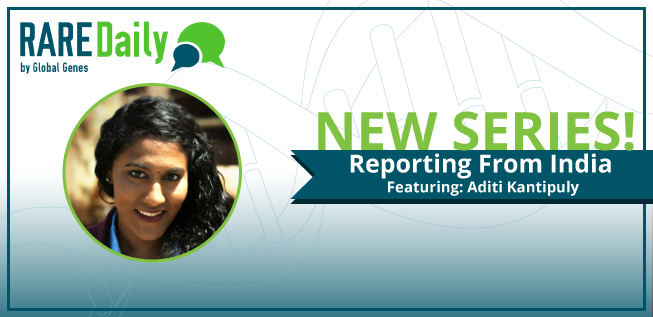Reporting From India: Experiencing the Repercussions of Consanguineous Marriages
January 26, 2016
I didn’t anticipate about writing on my first field visit, but I was deeply moved by the story of this three year old, pictured above–Dhivya. Dhivya is affected by congenital glaucoma. Dhivya and her family live in a small rural village, about 70 kilometers away from the nearest city. Dhivya’s home is not accessible by car, we had to walk about 10 minutes from the main road to reach her.
The concept of health equality is something I struggle with. The World Health Organization (WHO) states the enjoyment of the highest attainable standard of health is one of the fundamental rights of every human being, yet for rare disease patients, especially those who live in rural India, the above mentioned right is barely a reality.
While most rare diseases ignore geographical, historical and political divides, congenital glaucoma is estimated to be more than three times as common in Southern India than in the United States. Why? At first glance, the answer is consanguineous marriages (children from these types of marriages, are at greater risk for inheriting recessive genes, which could mean bad news in some cases). Yet, published studies to support this idea are riddled with significant ascertainment biases. Such biases include, young maternal age, parental socioeconomic status…list goes on. So, the short answer, it’s complex, and there are many factors at play.
If left untreated, congenital glaucoma, leads to profound blindness in children, presenting an economic burden not only on the family but society at large. This treatable condition has now robbed two productive members of society: both the parent and child. More importantly, congenital glaucoma has permanently compromised the quality of life for the family.
Lets now consider the healthcare system of India. There are striking disparities in the quality of healthcare available to urban and rural populations, with urban areas home to a quarter of Indian citizens but three quarters of India’s health infrastructure, including doctors, specialists, and other health resources. Clinician qualifications can vary greatly and a basic medical qualification can range from a 3-year undergraduate degree to an 8-year doctoral degree. Given the differences in the healthcare system and cultural practices, compared to developed countries, there is considerable value in investigating how these factors may influence the barriers to diagnosis and treatment of of a rare disorder in India.
>When I asked Dhivya’s mother (who married a relative), how she felt about her daughter’s condition, her response was that it was “God’s will”. It now effectively becomes of an issue of state vs religion. Other parents said they just left it “as is”, either because they had other children to worry about, or because they “felt it would resolve on its’ own”.
Coming from a public health perspective, do we encourage banning the age old (for at least thousands of years) practice of consanguineous marriages to prevent rare diseases (in this case congenital glaucoma)? Sure, in modern western society, marrying your cousin or anyone related to you, is taboo, particularly in the United States. What about for other cultures? To what extent do societal-cultural practices (especially age old ones) triumph scientific facts?
Most of these parents are illiterate, and if you contemplate on that, therein lies your answer. Health literacy. The very foundation of the much needed sustainable bridge between physicians and rural patients lies on health literacy. It’s cheap, effective, no fancy equipment. Individuals need to be empowered with knowledge. While I’m a proponent of “to each his own”, I still can’t help but wonder what the outcome would be, if this 3 year old’s mother had known that she had a window of opportunity to save her daughter’s sight.
If you would like to read more about my work, you can do so here.
And as always-happy to answer questions or respond to comments!
Update: We recently confirmed the correct diagnosis for the child to be Wardenberg Syndrome. This speaks to the huge challenge of identifying correct diagnoses for rare diseases in low resource settings

Learn more about Aditi, her mission and the Fullbright Scholarship in her first post here.

Stay Connected
Sign up for updates straight to your inbox.
